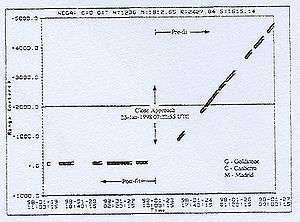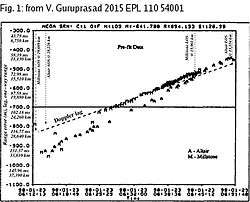Flyby anomaly
| | Unsolved problem in physics: What causes the unexpected change in acceleration for flybys of spacecraft? (more unsolved problems in physics) |
The flyby anomaly is an unexpected energy increase during Earth flybys of spacecraft. This anomaly has been observed as shifts in the S-band and X-band Doppler and ranging telemetry. Taken together, it causes a significant unaccounted velocity increase of up to 13 mm/s during flybys.[1] Numerically larger discrepancies (400–1000 m) have been observed at least in one flyby (NEAR) against Space Surveillance Network (SSN) radars.
Observations
Gravitational assists are valuable techniques for Solar System exploration. Because the success of these flyby maneuvers depends on the geometry of the trajectory, the position and velocity of a spacecraft is continually tracked during its encounter with a planet by the Deep Space Network (DSN).


The flyby anomaly was first noticed during a careful inspection of DSN Doppler data shortly after the Earth flyby of the Galileo spacecraft on 8 December 1990. While the Doppler residuals (observed minus computed data) were expected to remain flat, the analysis revealed an unexpected 66 mHz shift, which corresponds to a velocity increase of 3.92 mm/s at perigee. Investigations of this effect at the Jet Propulsion Laboratory (JPL), the Goddard Space Flight Center (GSFC) and the University of Texas have not yielded a satisfactory explanation. No anomaly was detected after the second Earth flyby of the Galileo spacecraft in December 1992, where the measured velocity decrease matched that expected from atmospheric drag at the lower altitude of 303 km. However, the drag estimates had large error bars, and so an anomalous acceleration could not be ruled out.[2]
On 23 January 1998 the Near Earth Asteroid Rendezvous (NEAR) spacecraft experienced an anomalous velocity increase of 13.46 mm/s after its Earth encounter. Cassini–Huygens gained around 0.11 mm/s in August 1999, and Rosetta gained 1.82 mm/s after its Earth flyby in March 2005.
An analysis of the MESSENGER spacecraft (studying Mercury) did not reveal any significant unexpected velocity increase. This may be because MESSENGER both approached and departed Earth symmetrically about the equator (see data and proposed equation below). This suggests that the anomaly may be related to Earth's rotation.
In November 2009, ESA's Rosetta spacecraft was tracked closely during flyby in order to precisely measure its velocity, in an effort to gather further data about the anomaly, but no significant anomaly was found.[3][4]
The 2013 flyby of Juno on the way to Jupiter yielded no anomalous acceleration.[5]
Summary of Earth-flyby spacecraft is provided in table below.[3][6]
| Quantity | Galileo I | Galileo II | NEAR | Cassini | Rosetta-I | Messenger | Rosetta-II | Rosetta-III | Juno | Hayabusa 2 |
|---|---|---|---|---|---|---|---|---|---|---|
| Date | 1990-12-08 | 1992-12-12 | 1998-01-23 | 1999-08-18 | 2005-03-04 | 2005-08-02 | 2007-11-13 | 2009-11-13 | 2013-10-09 | 2015-12-03 |
| Speed at infinity, km/s | 8.949 | 8.877 | 6.851 | 16.01 | 3.863 | 4.056 | 4.7 | |||
| Speed at perigee, km/s | 13.738 | — | 12.739 | 19.03 | 10.517 | 10.389 | 12.49 | 13.34 | 10.3 | |
| Impact parameter, km | 11261 | 12850 | 8973 | 22680.49 | 22319 | |||||
| Minimal altitude, km | 956 | 303 | 532 | 1172 | 1954 | 2336 | 5322 | 2483 | 561[7] | 3090[8] |
| Spacecraft mass, kg | 2497.1 | 730.40 | 4612.1 | 2895.2 | 1085.6 | 2895 | 2895 | ~2720 | 590 | |
| Trajectory inclination to equator, degrees | 142.9 | 138.9 | 108.8 | 25.4 | 144.9 | 133.1 | ||||
| Deflection angle, degrees | 47.46 | 51.1 | 66.92 | 19.66 | 99.396 | 94.7 | 80 | |||
| Speed increment at infinity, mm/s | 3.92±0.08 | −4.60±1.00 | 13.46±0.13 | −2±1 | 1.82±0.05 | 0.02±0.01 | ~0 | ~0 | ~0[5] | ? |
| Speed increment at perigee, mm/s | 2.56±0.05 | 7.21±0.07 | −1.7±0.9 | 0.67±0.02 | 0.008±0.004 | ~0 | −0.004±0.044 | ? | ||
| Gained energy, J/kg | 35.1±0.7 | 92.2±0.9 | 7.03±0.19 | ? |
Future research
Upcoming missions with Earth flybys include BepiColombo with its launch due in January 2017 and its Earth flyby due July 2018.
Some missions designed to study gravity, such as STEP, will make extremely accurate gravity measurement and may shed some light on the anomaly.[9]
Proposed equation
An empirical equation for the anomalous flyby velocity change was proposed by J. D. Anderson et al.:
where ωE is the angular frequency of the Earth, RE is the Earth radius, and φi and φo are the inbound and outbound equatorial angles of the spacecraft.[10] (This does not consider the SSN residuals – see "Possible explanations" below.)
Possible explanations
There have been a number of proposed explanations of the flyby anomaly, including:
- Unaccounted transverse Doppler effect—i.e. the redshift of light source with zero radial and non-zero tangential velocity.[11] However, this cannot explain the similar anomaly in the ranging data.
- A dark-matter halo around Earth.[12]
- A modification of inertia resulting from a Hubble-scale Casimir effect, related to the Unruh effect (MiHsC).[13][14]
- The impact of general relativity, in its weak-field and linearized form yielding gravitoelectric and gravitomagnetic phenomena like frame-dragging, has been investigated as well:[15] it turns out to be unable to account for the flyby anomaly.
- The classical time-retarded gravity explanation proposed by Joseph C. Hafele.[16]
- Range-proportional excess delay of the telemetry signal revealed by the United States Space Surveillance Network range data in the NEAR flyby.[17] This delay, accounting for the anomaly in both Doppler and range data, as well as the trailing Doppler oscillations, to within 10–20%, points to chirp modes in the reception due to the Doppler rate, predicting a positive anomaly only when the tracking by DSN is interrupted around perigee, and zero or negative anomaly if tracked continuously. No anomaly should occur in Doppler tracked by non-DSN stations.[18]

See also
References
- ↑ "ESA's Rosetta spacecraft may help unravel cosmic mystery". European Space Agency. November 12, 2009. Retrieved 13 March 2010.
- ↑ C, Edwards, J. Anderson, P, Beyer, S. Bhaskaran, J. Borders, S. DiNardo, W. Folkner, R. Haw, S. Nandi, F. Nicholson, C. 0ttenhoff, S. Stephens (1993). "TRACKING GALILEO AT EARTH-2 PERIGEE USING THE TRACKING AND DATA RELAY SATELLITE SYSTEM".. The two [measurement] methods yielded similar fits to the data. Within an uncertainty of eight percent, both methods yielded a decrease in velocity along track of −5.9±0.2 mm/s. A priori predictions for the drag-induced velocity change, based on the Jacchia–Roberts model, were −6.2±4.O mm/s [5], clearly consistent with the observed velocity change. In contrast, DSN data from the December 1990 Earth flyby, at altitude 956 km, indicated an unexplained increase in along-track velocity of 4 mm/s, after accounting for the much smaller drag effects. Given the uncertainty in drag models, we cannot conclusively rule out the possibility that a similar increase occurred at Earth 2. For example, an unmodeled increase of 4 mm/s and a drag decrease of −10 mm/s would be compatible with our results and our a priori atmospheric model. Significantly larger anomalous velocity increases, however, would appear inconsistent with the drag model.
- 1 2 "Mystery remains: Rosetta fails to observe swingby anomaly". ESA. Archived from the original on 2009-12-23.
- ↑ J. Biele (2012). "Navigation of the interplanetary Rosetta and Philae spacecraft and the determination of the gravitational field of comets and asteroids - (DLR) @ TU München, 2012" (PDF). Retrieved 2014-11-18.
- 1 2 Thompson, Paul F., Matthew Abrahamson, Shadan Ardalan, and John Bordi. (2014). Reconstruction of Earth flyby by the Juno spacecraft. AAS/AIAA Space Flight Mechanics Meeting; 24th;. Santa Fe, NM: AAS,. pp. 14–435.
- ↑ Anderson, John D.; James K. Campbell; Michael Martin Nieto (July 2007), "The energy transfer process in planetary flybys", New Astronomy, 12 (5): 383–397, arXiv:astro-ph/0608087
 , Bibcode:2007NewA...12..383A, doi:10.1016/j.newast.2006.11.004
, Bibcode:2007NewA...12..383A, doi:10.1016/j.newast.2006.11.004 - ↑ NASA’S JUNO SPACECRAFT RETURNS 1ST FLYBY IMAGES OF EARTH WHILE SAILING ON TO JUPITER
- ↑ Hayabusa2 Earth Swing-by Result
- ↑ Páramos, Jorge; Hechenblaikner, G. (2013). "Probing the Flyby Anomaly with the future STE-QUEST mission". Planetary and Space Science. 79-80: 76. arXiv:1210.7333
 . Bibcode:2013P&SS...79...76P. doi:10.1016/j.pss.2013.02.005.
. Bibcode:2013P&SS...79...76P. doi:10.1016/j.pss.2013.02.005. - ↑ Anderson; et al. (7 March 2008), "Anomalous Orbital-Energy Changes Observed during Spacecraft Flybys of Earth" (PDF), Phys. Rev. Lett., 100 (9): 091102, Bibcode:2008PhRvL.100i1102A, doi:10.1103/physrevlett.100.091102, PMID 18352689.
- ↑ Mbelek, J. P. (2009). "Special relativity may account for the spacecraft flyby anomalies". arXiv:0809.1888
 [qr-qc].
[qr-qc]. - ↑ S.L.Adler (2008), "Can the flyby anomaly be attributed to Earth-bound dark matter?", Physical Review D, 79 (2): 023505, arXiv:0805.2895
 , Bibcode:2009PhRvD..79b3505A, doi:10.1103/PhysRevD.79.023505
, Bibcode:2009PhRvD..79b3505A, doi:10.1103/PhysRevD.79.023505 - ↑ M. E. McCulloch (2008), "Modelling the flyby anomalies using a modification of inertia", MNRAS Letters, 389 (1): L57–L60, arXiv:0806.4159
 , Bibcode:2008MNRAS.389L..57M, doi:10.1111/j.1745-3933.2008.00523.x
, Bibcode:2008MNRAS.389L..57M, doi:10.1111/j.1745-3933.2008.00523.x - ↑ https://www.technologyreview.com/s/601299/the-curious-link-between-the-fly-by-anomaly-and-the-impossible-emdrive-thruster/
- ↑ L. Iorio (2009), "The Effect of General Relativity on Hyperbolic Orbits and Its Application to the Flyby Anomaly", Scholarly Research Exchange, 2009: 1, arXiv:0811.3924
 , Bibcode:2009ScReE2009.7695I, doi:10.3814/2009/807695, 807695
, Bibcode:2009ScReE2009.7695I, doi:10.3814/2009/807695, 807695 - ↑ http://www.ptep-online.com/index_files/2013/PP-33-01.PDF - Causal Version of Newtonian Theory by Time–Retardation of the Gravitational Field Explains the Flyby Anomalies
- ↑ P. G. Antreasian; J. R. Guinn (1998), "Investigations into the unexpected delta-v increase during the Earth Gravity Assist of GALILEO and NEAR" (PDF), AIAA/AAS Astrodynamics Specialist Conf. and Exhibition, Boston, paper no. 98-4287
- ↑ V. Guruprasad (2015), "Observational evidence for travelling wave modes bearing distance proportional shifts", EPL, 110 (5): 54001, arXiv:1507.08222
 , Bibcode:2015EL....11054001G, doi:10.1209/0295-5075/110/54001
, Bibcode:2015EL....11054001G, doi:10.1209/0295-5075/110/54001
Literature
- J. D. Anderson; J. G. Williams (2001), "Long-range tests of the equivalence principle", Class. Quantum Grav., 18 (13): 2447–2456, Bibcode:2001CQGra..18.2447A, doi:10.1088/0264-9381/18/13/307.
- C. Lämmerzahl; O. Preuss; H. Dittus (2006), "Is the physics within the Solar system really understood?", Proceedings of the 359th WE-Heraeus Seminar on "Lasers, Clocks, and Drag-Free: Technologies for Future Exploration in Space and Tests of Gravity", arXiv:gr-qc/0604052
 Associated presentation slides.
Associated presentation slides. - J. D. Anderson; J. K. Campbell; M. M. Nieto (2006), "The Energy Transfer Process in Planetary Flybys", New Astronomy, 12 (5): 383, arXiv:astro-ph/0608087
 , Bibcode:2007NewA...12..383A, doi:10.1016/j.newast.2006.11.004.
, Bibcode:2007NewA...12..383A, doi:10.1016/j.newast.2006.11.004. - NASA Baffled by Unexplained Force Acting on Space Probes (2008), at Space.com.
- J. D. Anderson; J. K. Campbell; J. E. Ekelund; J. Ellis; J. F. Jordan (2008), "Anomalous Orbital-Energy Changes Observed during Spacecraft Flybys of Earth" (PDF), Phys. Rev. Lett., 100 (91102): 091102, Bibcode:2008PhRvL.100i1102A, doi:10.1103/PhysRevLett.100.091102.
- Wanted: Einstein Jr (2008), at Economist.com.
- K. Svozil (2007). "Microphysical analogues of flyby anomalies". New Astronomy. 12 (5): 383. arXiv:0804.2198
 . Bibcode:2007NewA...12..383A. doi:10.1016/j.newast.2006.11.004.
. Bibcode:2007NewA...12..383A. doi:10.1016/j.newast.2006.11.004.
External links
- Lämmerzahl, Claus (2008). "The Pioneer Anomaly or Do We Really Understand the Physics With the Solar System?" (pdf; 6.25 MB, talk/slides). Center for Applied Space Technology and Microgravity. University of Bremen. p. 123.
- Aste, Andreas (2008). "Spacecraft Anomalies: An Update" (pdf; 9.8 MB, talk/slides). Department of Physics. University of Basel. p. 29.
